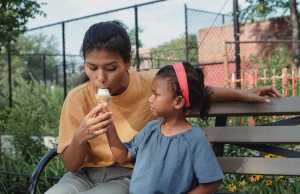Every year there seems to be a new parenting style trending in popular culture: helicopter parenting, tiger parenting, lighthouse parenting. People write about free-range parenting, gentle parenting, and slow parenting as if children are food items that need to be carefully cultivated through a certain recipe. Child psychologists and mommy/daddy bloggers argue about the best way to raise healthy kids. Dads clash with dads about setting consistent boundaries for toddlers. Moms clash with moms about extending curfews for their teenagers. And once again stressed-out parents are up late at night, reading countless books and articles about how to shape their children’s ideal futures, asking themselves, “Am I doing everything wrong?”
Most parents aren’t raising their kids based on pop culture. They’re using their own instincts and creativity. They’re drawing from their own childhoods and formative attachment models. They’re being flexible, adapting their preconceived notions about what constitutes “good parenting” based on their kids’ personalities, ages, temperaments, and individual needs. All families can’t raise children by the same bestseller.
But there are some evidence-based parenting philosophies that seem to benefit most kids. These aren’t specific practices but general attitudes and strategies that parents can employ imprecisely. They probably won’t make or break your family, but they might help your children develop confidence, independence, and emotional regulation–qualities that can serve them well into adulthood. Welcome to the Thriveworks guide to parenting styles!

What Are Parenting Styles?
Parenting styles are a collection of psychology-based strategies that parents use to raise their kids with the hope that their offspring will grow up to be happy, secure, and successful in achieving their goals. By the way, if you’re reading this, you’re probably a good parent. Abusive parents (more on them later) aren’t typically asking themselves how they can help their children thrive. Studies on parenting styles tend to focus on “normal” parents who are trying their best, not the parents who exhibit toxic deviations in the way they treat their children.
A parenting style is typically defined by variations in a parent’s 1) responsiveness and 2) demandingness. This typology was created by researcher Diana Baumrind in the 1980s, and it’s still used today. Responsiveness and demandingness are huge categories that can incorporate the following elements:
- Care
- Warmth
- Sensitivity
- Positivity
- Nurturing
- Support
- Involvement
- Approval
- Expectations
- Control
- Consistency
- Discipline
- Monitoring
- Punishment
- Leniency
- Negativity
- Attachment
- Parental stress
- Cultural factors
- Risk aversion
Parenting styles are all about the quality of interaction between parent and child. Styles are different from parenting practices in that the former creates a certain psychological climate, rather than prescribing exactly what children should and shouldn’t do. Styles are the context within which practices happen. So “showing love and affection” can be part of a parenting style, but “limiting screen time” is a parenting practice.
Why Are Parenting Styles Important?
Parenting styles influence child outcomes. Children are dependent on their caregivers, after all. Parenting approaches have an outsized effect on children’s emotional lives and behaviors because they broadly define kids’ day-to-day interactions. The quality of those daily interactions can add up in time to shape a child’s worldview: what they expect from relationships, how they bounce back from adversity, and how they feel about themselves. Parenting styles have also been shown to influence long-term physical and mental health. For example:
- Parental overprotection is associated with lower self-esteem and higher psychological inflexibility in adolescents.
- Low parental care and high overprotection during childhood increase the risk of chronic pain in adulthood.
- High maternal care is associated with lower odds of behavioral, depressive, and eating disorders in adolescents. High maternal control is associated with higher odds of adolescents having those conditions.
- High paternal care is associated with lower odds of social phobia and alcohol abuse in adolescents. High paternal control is associated with greater odds of agoraphobia and alcohol abuse, but with lower odds of attention-deficit/hyperactivity disorder (ADHD).
Granted, some of these associations may not be as strong as, say, genetics, but they do seem to matter.
How Many Parenting Styles Are There?
In the literature of child psychology and child development, there are four main parenting styles:
- Authoritarian. Authoritarian parents are demanding but not responsive. They favor strict rules and disciplinary measures, but they don’t communicate their reasons to the child. They exert a high degree of parental control without inviting feedback from their children.
- Permissive/Indulgent. Permissive parents are responsive but not demanding. They nurture their children but don’t ask them to regulate their behaviors. They’re the “cool” parents–the friends–who don’t enforce rules and limits.
- Uninvolved. Uninvolved parents are not responsive and not demanding. This is also called a neglectful parenting style. These parents are essentially indifferent toward their children, not caring what they do.
- Authoritative. Authoritative parents are demanding and responsive. These parents expect their children to learn to behave and regulate themselves through a process of nurturing, communication, mutual understanding, and age-appropriate autonomy.
But in popular culture, there are countless parenting styles–more defined every day. And the perception of parenting and parents’ roles can vary from country to country and culture to culture.
What Are the Different Parenting Styles?
You may recognize some of these parenting styles from popular books and articles. This is by no means an exhaustive list because new approaches are always being coined, but it’s a start!
- Abusive, which is characterized by active emotional or physical harm to children
- Affectionless control, which is characterized by parents who lack warmth/care but exert significant control over their children
- Alloparenting, where primary caregivers raise children with their community, i.e., they use “the village”
- Attachment, which is parenting framed around children being securely attached
- Authoritarian (see section above)
- Authoritative (see section above)
- Child-centered, which focuses on the unique personhood of every child
- Commando, which means doing whatever it takes to get desired outcomes
- Concerted cultivation (see positive parenting)
- Differential, where siblings are raised differently within the same household
- Dolphin, a playful style that can be contrasted with tiger parenting
- “Ethnic minority”, which is how some Westerners refer to a kind of authoritarian parenting that tends to be favored by Asian families
- Free-range, which is a mostly hands-off approach to parenting
- Gentle, which focuses on empathy and respect
- Helicopter parenting (see overparenting)
- Lawnmower, when parents personally cut down every obstacle in their childrens’ path
- Lighthouse, where parents are available to guide their children but mostly maintain a hands-off/free-range approach
- Narcissistic, where parents are threatened by or possessive of their children
- Nurturant, which is characterized by responsive and empathetic parents
- Overparenting, which aims to solve all the child’s problems so they don’t have to
- Pathogenic, which is parenting so dysfunctional that children can develop psychopathology
- Permissive/indulgent (see section above)
- Positive, which overlaps with authoritative parenting
- Propagative, which overlaps with authoritative parenting
- Reflective, which focuses on reflective functioning, or the ability to imagine your own and other peoples’ mental states
- Slow, where children are left to their own devices and aren’t overscheduled or over-organized by their parents
- Tiger, which is a tough-love approach that pushes children to succeed in the real world
- Toxic, which is characterized by a psychologically toxic relationship between parent and child
- Uninvolved (see section above)
What Is the Most Common Parenting Style?
In the United States, an authoritative parenting style is the most popular. It sets high standards and expectations for kids without sacrificing warmth and compassion. It fosters independence without sacrificing involvement. And it lets kids take risks without sacrificing learning opportunities. With an authoritative parenting style, kids can ideally grow up to be reasonable, confident, successful problem-solvers with good social skills who are driven by an internal moral compass. Ideally.
What Is the Best Parenting Style?
In Western culture, psychologists largely agree that the authoritative parenting style is most beneficial for children’s mental health and development. Authoritative parents maintain consistent, nurturing relationships with their children without sacrificing healthy limits. Discipline is used as a support rather than a punishment, and communication is frequent and productive. It’s a type of parenting that requires both patience and effort, but all the trouble tends to pay off. Children of authoritative parents tend to develop the following:
- Greater independence and higher self-esteem
- Emotional self-regulation
- Academic success (though this isn’t true across the board)
Video: How to Be an Authoritative Parent
Important note: In Asian countries, an authoritarian parenting style is associated with equally positive outcomes. See the section on cultural differences in parenting below.
How Does Parenting Style Affect Child Development?
There are so many different factors that influence child development–from genetics to infant attachment to nutrition to adverse childhood experiences (ACEs) to peer relationships to socioeconomic status–that it’s always hard to isolate the importance of one factor over another. Nevertheless, child psychologists continue to try to enhance the mental well-being of all children by studying how parenting styles affect some outcomes. And they’ve made a lot of progress. For example:
Studies show that nurturing is critical for a child’s healthy development. Nurturing environments do the following:
- Minimize events that could be psychologically toxic to a child
- Reinforce prosocial behavior
- Reduce behavior problems
- Encourage psychological flexibility
Some parenting styles are associated with negative outcomes. For example, permissive parents may allow unlimited snacks, leading to bad eating habits and obesity. Indulgent parenting can also contribute to a child’s impulsivity and selfishness. Children of authoritarian parents may not know how to regulate their own behavior without the risk of punishment. They may be rebellious, poorly behaved, and have low self-esteem. And the children of uninvolved/neglectful parents may struggle academically and experience relationship difficulties.
How Does Culture Affect Parenting Styles?
Culture can affect parenting styles in a variety of ways. As an extreme example, corporal punishment (e.g., spanking) might be morally unacceptable in some countries and an integral part of authoritarian childrearing in others. Most studies about parenting styles have been conducted in English-speaking, affluent countries like the United States. Cultural elements that may influence parenting styles include the following:
- Values
- Family structure
- Health/nutrition/hygiene
But when looking at cultural differences in parenting styles, it’s also important to remember what’s universal. For example, parents everywhere love their children and want them to succeed. And caregiver responsiveness is critical no matter where you live.
When Parenting Styles Differ, What Do You Do?
When you decide to raise a child with someone else, you can’t entirely predict what kind of parent your partner will be. You were raised in different households, by different caregivers, sometimes within different cultures, and thus it’s easy to have developed different ideas about how children should optimally be raised. When you’re in this situation–which is very common in co-parenting–it’s important to find ways to navigate your contrasting styles. So how do you do that?
- Be willing to reflect on your own parenting style and the values that shape it. Do you have to recreate the way you were raised, or can you do things a little differently?
- Remember that parenting is hard! And stressful! And tiring! Putting a toddler to bed can occasionally feel like psychological warfare. It’s completely normal to clash with your co-parent from time to time.
- Focus on how your parenting styles might complement each other. Maybe your partner’s more permissive nature can even out your more authoritarian nature.
- Agree on some rules, and don’t break them.
- Don’t undermine or contradict the other parent in front of the children unless the conversation can stay friendly and solution-focused. Then children can see how productive, healthy conflicts get resolved.
- If your children witness arguments, make sure they witness resolution and apologies as well.
- Educate yourselves on what children need most from their caregivers.
- Forgive yourself when you don’t get it right every time.
- Seek family counseling or couples therapy to talk through these sensitive issues in a safe, solution-focused way.
How Do You Blend Families with Different Parenting Styles?
Many families are beautifully blended, not created from scratch. This means that stepmothers, stepfathers, stepchildren, foster children, etc., may enter the mix when parenting styles are already established. This can lead to inconsistency and feelings of unfairness, favoritism, or defensiveness. So what do you do to blend families with different parenting styles? You do the following:
- First and foremost, you communicate. Talk to your partner about the values that drive your parenting choices. Maybe you agree on general principles, but not specific methods, and you can actually find some common ground. Schedule adult discussions with your partner, and family meetings with the kids.
- Let the original parent do most of the disciplining.
- Don’t undermine or contradict your partner’s methods in front of the children. Try to talk things through in private, not in the heat of the moment. If you do argue in front of the kids, keep it respectful.
- Seek a qualified family therapist who can help smooth transitions.













